Ryan Starling entered the blazing single-story building carrying 57 pounds of gear—including an air pack to help him breathe through the noxious fumes. Now he and his partner needed to shoulder 190 pounds more.
They were in a back room in the San Bernardino Valley building and found an unconscious man. No time to waste. Starling and his partner grabbed the man and started the 100-foot trek out of the burning building, a tag-team farmer’s carry with a purpose. Four years later, the experience is an example of something Starling, 37, knows well: When you’re in the business of saving lives, muscle matters. “It’s our duty to stay in shape all the way through our career,” he says. “At the end of the day, this is your responsibility, your job, your calling.”
Everyone at San Bernardino Fire Station 221, in southern California, seems to understand that. The station is leading a new wave at firehouses around the country, lifesaving units that crush five-alarm fires and afternoon WODs. More and more, when crews aren’t on a “run”( firefighter-speak for their calls), they’re running around the firehouse, sandbags on their shoulders, prepping their bodies for whatever fiery hell might come next.
The Firehouse Gym Experience
Station 221 itself is a hub of tactical strength and conditioning. Beyond the bay that houses its two fire engines and one tiller truck is a 25-by-25-foot functional-fitness area. It was a closet until it was redesigned last year. Now it contains bumper plates, kettlebells, Concept2 rowers, Assault AirBikes, and a Rogue-inspired rack complete with pullup bars of different heights. There’s another section that includes a Smith machine—Starling calls this the “globo-gym,” a CrossFit reference to chain gyms.
Starling, a career firefighter, helped bring fitness to Station 221—and to his other job as a SWAT medic—about six years ago. He’d been around gyms for much of his life, typically doing bodybuilder-style workouts. But in January 2013, on a whim, he wandered into
a CrossFit box. He was instantly hooked.“I had always done some kind of circuit training,” he says, “but now it had some reason behind it. Now you have a competition, and that’s what draws me in.”
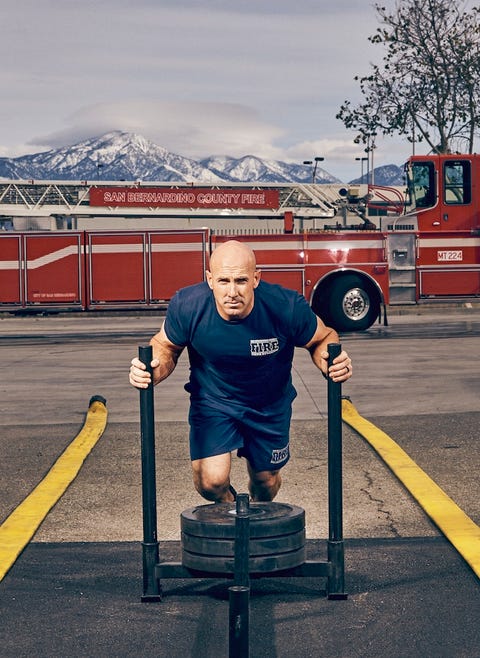
Cody Pickens
Station 221, like many firehouses, was primed for a strong dose of fitness. On any given call, firefighters push, pull, twist, lift, throw, and hinge—all things you might do in a smart sweat sesh. As Starling built his own strength, emerging as a four-time Regionals participant and finishing seventh in his age category at the 2018 U. S.CrossFit Open, he realized his training aided him in his roles in the fire department and law enforcement.
Fitness is a growing trend among first responders, and firefighters regularly tailor their routines to their job. Starling’s workouts (we’re calling them “tactical CrossFit”), for example, emphasize pushing exercises like shoulder presses, since firefighters need extra strength to push open doors and break through walls. He makes use of sandbags as well, challenging his mates to bear unpredictable loads, like the 190-pound man he helped drag from that building. At other firehouses, firefighters haul weights and sandbags, both over the shoulder and while backpedaling, mimicking how they carry a hose into a blaze (which is more taxing than you might think).
Starling also programs vicious cardio-style workouts on the Assault AirBike. (Think 30 seconds on, 30 seconds off, until you reach 200 calories.) Cardio and endurance, he says, are key for firefighters. “During long, extended incidents, your cardio and endurance take over,” he says. “Your heart rate spikes, and then it stops, then you do it again.”
He recalls a recent eight-hour SWAT team call that ended with the team deploying tear gas to force suspects out of hiding. The SWAT team had to use masks, which make breathing a chore. Starling was right at home in this oxygen-deprived environment. “You’re training your body for your job,” he says.
First Responder Fitness Prep Is Paying Off
Firefighters injury-proof their bodies, too. A recent study in the journal Injury Prevention found that probationary firefighters and recruits led fewer injury claims as a result of basic fitness intervention, saving one department $33,000 in claims costs. “The stronger they are, the harder they are to break,” says John Hofman, C.S.C.S.*D, director of tactical strength and conditioning at Southern California University Health System. “If you want to reduce musculoskeletal injuries, get them strong.”
First-responder bases are focusing more on strength. The LAPD’s elite Metro-unit officers must start every shift with 90 minutes of gym work. A coast away, in New York, each Yonkers firefighter can get a stipend of up to $1,200 toward gym fees. “Every single firehouse in our city has a gym,” says Yonkers firefighter Frank D’Agostino.
Plenty of firehouses have somebody like Starling, who trains before work, sometimes at 4:00 a.m. And when he trains at Station 221, he loves a little friendly competition. “I’ll tailor my workouts to get other guys involved,” he says. The person who performs worst does the one thing no workout can prep you for, says Starling. “Whoever loses cooks dinner.”
Get Tactical Fit
Forge total-body fitness—and lifesaving strength—with this circuit from Starling. Do 4 rounds, resting as needed. Do 20 reps of each move the first round, 15 the second, 10 the third, and 5 the fourth. Don a 25-pound weight vest for even more challenge.
Sandbag Squat
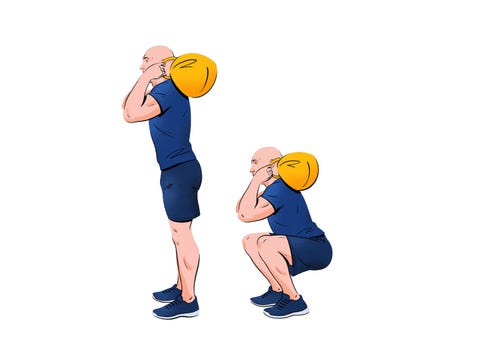
Ben Mounsey-Wood
Place a sandbag on your shoulders and stand with your feet shoulder width apart (a). Bend your knees and hips until your thighs are parallel to the floor (b); stand back up. That’s 1 rep.
Why It Helps: You’re frequently carrying gear (or people) on your shoulders.“And legs are the foundation,” says Starling.
Sandbag Clean and Press

Ben Mounsey-Wood
Grasp a sandbag on the floor (a). Stand explosively and pull the bag upward. “Catch” it at your shoulders. Bend your knees, then explode upward, driving the bag overhead (b). That’s 1 rep.
Why It Helps: “You’re always doing a lot of pushing and pulling with your shoulders,” Starling says.
Chinup
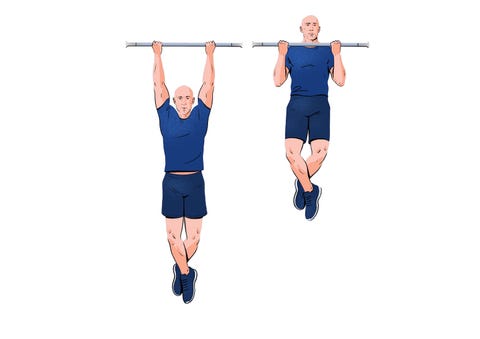
Ben Mounsey-Wood
Hang from a bar with an underhand grip (a). Squeeze your shoulder blades and pull your chest toward the bar (b). Pause, then lower slowly. That’s 1 rep. It’s okay to jump down between reps.
Why It Helps: You never know when you’ll have to scale a wall with your gear, and the chinup (or pullup) gets you started.
Burpee
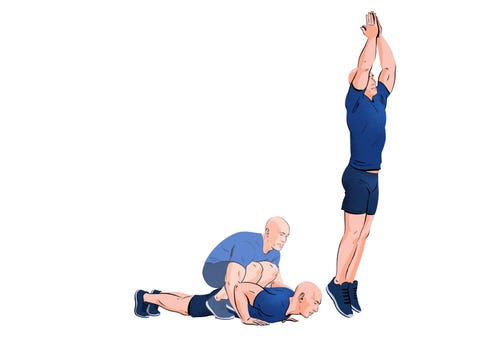
Ben Mounsey-Wood
Start standing. Squat down and put your hands on the floor. Jump your legs back into pushup position and lower your chest to the floor (a), then reverse the movements (b) to quickly stand up. That’s 1 rep.
Why It Helps: This wind-sucking, full-body move develops the cardio engine you need. “On a fire, I’m not even tired,” Starling says. “You stop thinking about the fatigue.”
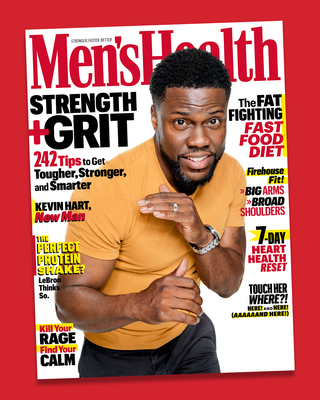
Men’s Health
Men’s Health Subscription
SHOP NOW
Source: Read Full Article
